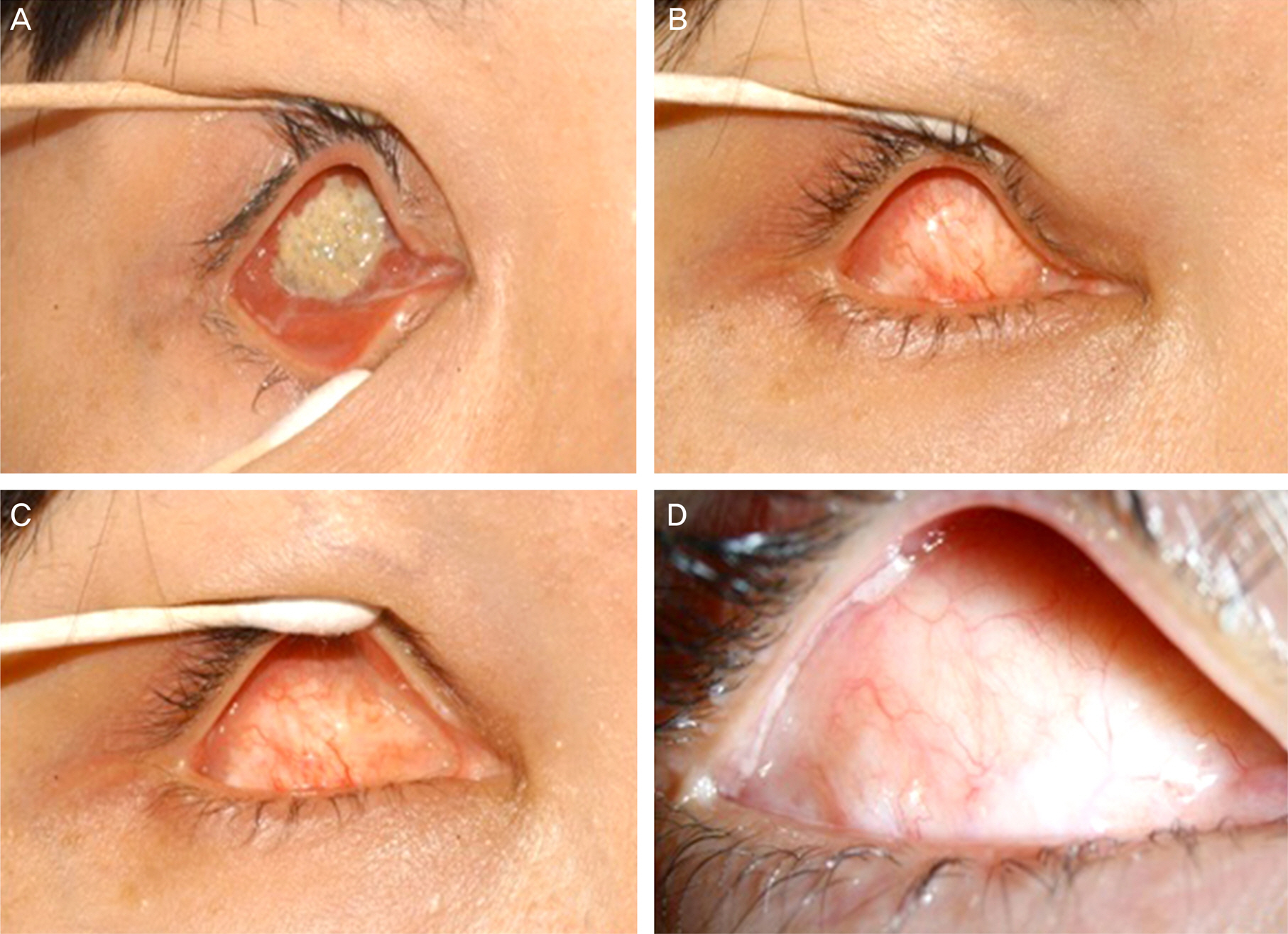J Korean Ophthalmol Soc.
2015 Feb;56(2):155-161. 10.3341/jkos.2015.56.2.155.
Clinical Outcomes Following Simultaneous Orbital Implant Insertion Operation and Dermo-Fat Graft for Anophthalmos Patients
- Affiliations
-
- 1Department of Ophthalmology, Pusan National University Hospital, Pusan National University School of Medicine, Busan, Korea. hychoi@pusan.ac.kr
- 2Biomedical Research Institute, Pusan National University Hospital, Busan, Korea.
- KMID: 2215996
- DOI: http://doi.org/10.3341/jkos.2015.56.2.155
Abstract
- PURPOSE
To investigate the clinical results of patients who have undergone simultaneous dermo-fat graft and insertion of orbital implants in patients who are unable to put on an ocular prosthesis due to severe conjunctival sac contracture or large orbital implant exposure.
METHODS
A retrospective analysis was performed of patients who underwent dermo-fat graft simultaneously with orbital implant insertion for replacement of the conjunctival sac from 2007 to 2012. Eight eyes were enrolled in this study and all patients were followed up for phthisis bulbi or implant exposure.
RESULTS
Among the eight eyes, five eyes (62.5%) that were diagnosed with orbital implant exposure underwent orbital implant exchange and dermo-fat graft, and two eyes (25%) were anophthalmic enophthalmic patients and underwent secondary orbital implant insertion and dermo-fat graft. One patient (12.5%) underwent orbital implant insertion and dermo-fat graft simultaneously during the evisceration operation. We followed the progress for 46.3 months. For seven out of eight eyes, the results of the wound healing process were successful. One patient underwent removal and reinsertion of the orbital implant with dermo-fat graft, and the wound in this case healed well. However, after five months, dermo-fat re-graft was performed for orbital implant re-exposure and it was not exposed thereafter. Overall cosmetic appearance was satisfactory in each patient, and all patients were able to comfortably retain a prosthesis.
CONCLUSIONS
We found that undergoing dermo-fat graft simultaneously when performing orbital implant insertion is effective for replacement of the conjunctival sac and orbital volume.
MeSH Terms
Figure
Reference
-
References
1. Yoon KC, Ji YS, Park YG. Management of exposed hydroxyapatite implant with acellular dermal allograft. J Korean Ophthalmol Soc. 2005; 46:927–32.2. Park MS, Kim KS, Baek SH, Lee TS. Management of exposed porous orbital implant with autogenous dermis graft. J Korean Ophthalmol Soc. 2001; 42:1127–32.3. Sohn KS, Kim JW, Lee TS. Clinical observation on reconstruction of the anophthalmic contracted socket in 28 eyes. J Korean Ophthalmol Soc. 1986; 27:471–4.4. Gougelmann HP. The evolution of the ocular motility implant. International Ophthalmology Clinics. 1970; 10:689–711.
Article5. Soll DB. The anophthalmic socket. Ophthalmology. 1982; 89:407–23.
Article6. Perry AC. Integrated orbital implants. Adv Ophthalmic Plast Reconstr Surg. 1990; 8:75–81.
Article7. Kostick DA, Linberg JV. Evisceration with hydroxyapatite implant. Surgical technique and review of 31 case reports. Ophthalmology. 1995; 102:1542–8. discussion 1548-9.8. You YS, Kim HY, Lee SY. Incidence and clinical course of implant exposure after hydroxyapatite implantation in anophthalmic socket. J Korean Ophthalmol Soc. 1997; 38:1694–9.9. Dutton JJ. Coralline hydroxyapatite as an ocular implant. Oph- thalmology. 1991; 98:370–7.
Article10. Li T, Shen J, Duffy MT. Exposure rates of wrapped and unwrapped orbital implants following enucleation. Ophthal Plast Reconstr Surg. 2001; 17:431–5.
Article11. McNab A. Hydroxyapatite orbital implants. Experience with 100 cases. Aust N Z J Ophthalmol. 1995; 23:117–23.
Article12. Oestreicher JH, Liu E, Berkowitz M. Complications of hydrox-yapatite orbital implants. A review of 100 consecutive cases and a comparison of Dexon mesh (polyglycolic acid) with scleral wrapping. Ophthalmology. 1997; 104:324–9.13. Custer PL, Trinkaus KM. Porous implant exposure: Incidence, management, and morbidity. Ophthal Plast Reconstr Surg. 2007; 23:1–7.
Article14. Nunery WR, Heinz GW, Bonnin JM. . Exposure rate of hydroxyapatite spheres in the anophthalmic socket: histopathologic correlation and comparison with silicone sphere implants. Ophthal Plast Reconstr Surg. 1993; 9:96–104.15. Remulla HD, Rubin PA, Shore JW. . Complications of porous spherical orbital implants. Ophthalmology. 1995; 102:586–93.
Article16. Yoon JS, Lew H, Kim SJ, Lee SY. Exposure rate of hydroxyapatite orbital implants a 15-year experience of 802 cases. Ophthalmology. 2008; 115:566–72.e2.17. Baek SH. Clinical effect of porous polyethylene (Medpor(r)) orbital implant. J Korean Ophthalmol Soc. 2000; 41:1858–63.18. Karcioglu ZA, al-Mesfer SA, Mullaney PB. Porous polyethylene orbital implant in patients with retinoblastoma. Ophthalmology. 1998; 105:1311–6.19. Rosen HM, McFarland MM. The biologic behavior of hydrox-yapatite implanted into the maxillofacial skeleton. Plast Reconstr Surg. 1990; 85:718–23.
Article20. Goldberg RA, Holds JB, Ebrahimpour J. Exposed hydroxyapatite orbital implants. Report of six cases. Ophthalmology. 1992; 99:831–6.21. Kim YD, Goldberg RA, Shorr N, Steinsapir KD. Management of exposed hydroxyapatite orbital implants. Ophthalmology. 1994; 101:1709–15.
Article22. Lee MJ, Khwarg SI, Choung HK. . Dermis-fat graft for treatment of exposed porous polyethylene implants in pediatric post-enucleation retinoblastoma patients. Am J Ophthalmol. 2011; 152:244–50.e2.
Article23. Lee BJ, Lewis CD, Perry JD. Exposed porous orbital implants treated with simultaneous secondary implant and dermis fat graft. Ophthal Plast Reconstr Surg. 2010; 26:273–6.
Article24. Smith B, Petrelli R. Dermis-fat graft as a movable implant within the muscle cone. Am J Ophthalmol. 1978; 85:62–6.
Article
- Full Text Links
- Actions
-
Cited
- CITED
-
- Close
- Share
- Similar articles
-
- Management of Acquired Anophthalmic Socket
- Treatment of Exposed Hydroxyapatite Orbital Implant Using Acellular Dermal Allograft
- The Effect of Enucleation in Childhood on Orbital Volumetric Growth
- Clinical Observation on Reconstruction of the Contracted Anophthalmic Socket by the Dermis-fat Graft
- Clinical Experience of the Secondary Hydroxyapatite Orbital Implant


